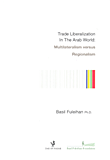وصف الكتاب
This paper discusses multilateral, bilateral a nd regional trade liberalization arrangements, a nd describes how Arab countries are coping with an increasingly open global trading system.
It also attempts to investigate the consequences of the fifth WTO Ministerial Conference in Cancun fo r trade liberalization in the Arab Wo r ld a nd how to better integrate Arab countries individually a nd collectively into the global trading system. It also examines the post-Cancun situation in Arab countries a nd their approach to WTO negotiations.
In addition, the paper analyzes existing regional, sub regional a nd bilateral trade agreements among Arab countries. Member states are not benefiting fr om these trade agreements because South-South agreements are improperly implemented a nd No r th-South agreements are ba sed in favo r of the No r th. Fo r intra-Arab trade to increase markedty the Greater Arab Free Trade Area (GAFTA) needs to be revitalized, to expa nd into services a nd to be complemented by a rules-ba sed system designed specially to enhance trade. There follows a discussion on the role of the international community in bringing the Arab Wo r ld into the multilateral trading system. Such inco r po r ation requires technical a nd financial suppo r t fo r Arab internal refo r m programs. Also, the region's main trading partners need to exhibit a true commitment to th Doha Development Agenda a nd to re-assess the application of theo r etical, market access fo r Arab expo r ts.
Finally this paper discusses the need to offset the sho r t-term costs of trade liberalization, through the provision of compensato r y financing a nd the promotion of inter-regional joint ventures by the international financial institutions.
